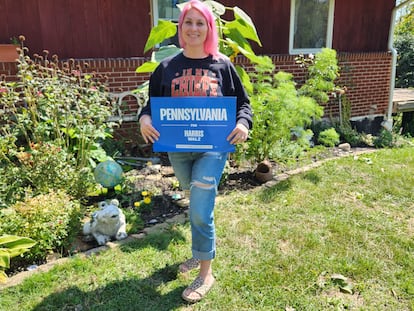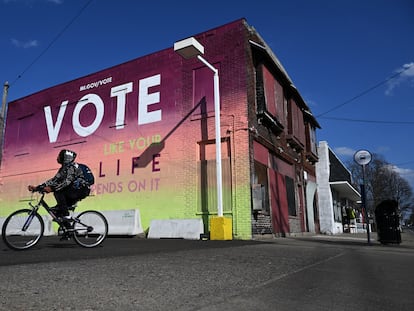In the county of the Donald Trump assassination attempt: ‘The attack has emboldened his supporters’
Democrats hope to increase their share of the vote in places like the Pennsylvania town of Butler, where a young man shot the former president at a rally


The news of an alleged second assassination attempt on Donald Trump felt like déjà vu in Butler. The Pennsylvania county where the first attack against Trump was perpetrated in July has still not recovered from the consequences of that event, which remains under investigation. Political divisions, according to some residents, have worsened in the Republican-majority town, located in a state — Pennsylvania — where every vote counts: it could end up deciding who will be the next president of the United States.
In Butler, the memory of what happened at that July 13 rally at the local farmers’ fairgrounds is still very much alive. Residents who weren’t there that day know someone who was. The iconic photograph of Trump bleeding with his fist raised can be seen on numerous posters. The Republican’s cry of “Fight! Fight! Fight!” has inspired graffiti on the street and on some mailboxes. A local artist has immortalized the image of the former president with his fist raised in a sculpture made of thousands of nails.
Last Friday, the U.S. Secret Service admitted in an investigative report on the case that there had been failures in communication, technology and in following up on reports of a suspect on the roof of one of the fairground’s sheds. The motives for the attack remain unclear: its perpetrator, 20-year-old Thomas Matthew Crooks, was a registered Republican voter but did not appear to have a strong political ideology.
Approaching Butler — a rural county of about 200,000 people 40 minutes north of the very Democratic city of Pittsburgh — one sees increasingly larger signs supporting the campaign of Donald Trump and his running mate, J.D. Vance. At the entrance to a farm, a trailer holds a full-length, larger-than-life portrait of the former president. On the grounds of another ranch, a large sign proclaims “Trump 2024: Save America Again.” Beyond it, a Confederate flag can be seen. On the main street, a picturesque road lined with charming shops and American flags, a jewelry store proclaims its support for the Armed Forces, amid a riot of stars and stripes.
Until this summer, few outside Pennsylvania had heard of Butler. With the possible exception of serious car enthusiasts: the prototype for the Jeep was invented in the county in the 1940s, a milestone still commemorated with street signs and an annual festival.
Today, it is a town in transition. Most of its residents still live on farms with generous acreage. But its relative proximity to Pittsburgh — Pennsylvania’s second-biggest city — makes it a convenient place to live and work in the city. Manufacturing jobs — once the area’s great economic engine — have been disappearing. But others have arrived thanks to companies in the business of fracturing shale gas, which is abundant in western Pennsylvania. A powerful steel mill provides more than a thousand jobs and good wages. Work is plentiful and well paid. While the trend in the rest of rural Pennsylvania is for young people to leave for cities, often from other states, Butler’s population continues to grow. After a period of economic depression, its downtown has been revitalized. New small businesses are popping up: a flower shop, a restaurant where pork is the specialty.
Trump territory
In places like Butler, Democrats are hoping to increase their share of the vote and add it to their large majority in the cities. The goal is to win Pennsylvania and its 19 electoral votes at the presidential elections on November 5. The Democrats need to win Pennsylvania to win the White House. On the other hand, Trump needs to win by a high number of votes in Butler and similar counties to win the state that he won in 2016 against Hillary Clinton, but lost in 2020 to Joe Biden by just 80,000 votes.
At first glance, the Democrats’ goal seems almost like a pipe dream. Butler is Trump territory: the Republican candidate won in the county in 2020 with 65% of the vote. There are around 80,000 registered Republican voters — more than a thousand of them registered after the attack — compared to just under 40,000 Democrats. A local businessman has become somewhat famous in the area for the electronic signs that, from his land, show drivers on the highway anti-LGBTQ messages. After the attack in July, the sign displayed messages accusing the Democrats of being behind the attack. An image of Kamala Harris, the Democratic presidential candidate, depicted her with devil horns and the message: “Democrats kill children and dreams.”
“The attack has emboldened a segment of the population that now supports Trump, even more so,” said educator Colleen Smith, 62, a Democrat from Butler. It is not uncommon, she and other residents say, to hear insults from vehicles passing by their pro-Harris signs.
That, Smith says, can be scary for some. “A teenager I knew by sight, a neighbor, recently walked past my house and told me he liked the pro-Harris sign I have at the entrance to my yard. I asked him if he wanted one, but he said no. He said, ‘There are too many Trump supporters in the neighborhood. We don’t feel safe, we don’t want to be targeted,’” she says. He ended up taking a small one, to keep in his room so no one would see it.

But others — specifically women — have decided to get organized. Heidi Priest, a 42-year-old real estate agent and self-described progressive mother of three, was concerned about the widespread support for Trump. And she decided to act. She used her experience as a mini-influencer — she has a Facebook baking page — to create a group on the social media site: “Butler PA Women for Harris.”
“I felt that we needed it. Until then, traditional Democratic groups were mostly for older women, but there were also many women of my generation who wanted to be involved in some way. Women who sent me private messages to tell me that at home they couldn’t express their opinions because their husband didn’t think the same way,” Priest tells EL PAÍS.
The group now has about 1,500 members, who hold regular meetings. The first one was cathartic, they say. About 80 women met in a small park in Butler. “It may seem like a small number, but for this area it’s a huge number,” Smith explains. “Women who showed up to say they were there for their daughters, for their granddaughters. Others said they came because they are mothers of someone who is a member of the LGBTQ+ community, and they need to know that they will be safe; others, because they have an autistic child and they don’t want to have a leader who mocks the disabled…”
“The group has also attracted younger people who are coming to defend their children in primary school,” adds the teacher. “There is a real sense of change in the tide. The enthusiasm is palpable, we no longer feel that we are alone.” Priest, who says she has received hostile messages on her office answering machine, is now considering entering politics at a local level.

There are also reports of friction among Republicans. Cindy Hildebrand is the chairwoman of the United Republicans of Butler County group and was at Trump’s rally in July. Speaking to the local Butler Eagle newspaper last week, she said: “It’s very sad how divided we are. It’s very sad that you can’t have a civil conversation with people.” Hildebrand said she had spent the previous two weeks canvassing door to door. “I went to some Democrat homes, and before I even said hello, they’re screaming at me, and all I want to do is have a conversation.”
But there are also encouraging moments. The graffiti urging “Fight, fight, fight” was scratched off a few weeks ago. Someone wrote instead: “Love.” “The fact that anyone bothered to try to counter that call to fight with a call to love is huge,” Smith says, smiling.
Sign up for our weekly newsletter to get more English-language news coverage from EL PAÍS USA Edition
Tu suscripción se está usando en otro dispositivo
¿Quieres añadir otro usuario a tu suscripción?
Si continúas leyendo en este dispositivo, no se podrá leer en el otro.
FlechaTu suscripción se está usando en otro dispositivo y solo puedes acceder a EL PAÍS desde un dispositivo a la vez.
Si quieres compartir tu cuenta, cambia tu suscripción a la modalidad Premium, así podrás añadir otro usuario. Cada uno accederá con su propia cuenta de email, lo que os permitirá personalizar vuestra experiencia en EL PAÍS.
¿Tienes una suscripción de empresa? Accede aquí para contratar más cuentas.
En el caso de no saber quién está usando tu cuenta, te recomendamos cambiar tu contraseña aquí.
Si decides continuar compartiendo tu cuenta, este mensaje se mostrará en tu dispositivo y en el de la otra persona que está usando tu cuenta de forma indefinida, afectando a tu experiencia de lectura. Puedes consultar aquí los términos y condiciones de la suscripción digital.
More information
Archived In
Últimas noticias
Most viewed
- Oona Chaplin: ‘I told James Cameron that I was living in a treehouse and starting a permaculture project with a friend’
- Sinaloa Cartel war is taking its toll on Los Chapitos
- Reinhard Genzel, Nobel laureate in physics: ‘One-minute videos will never give you the truth’
- Why the price of coffee has skyrocketed: from Brazilian plantations to specialty coffee houses
- Silver prices are going crazy: This is what’s fueling the rally










































